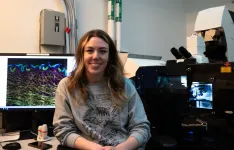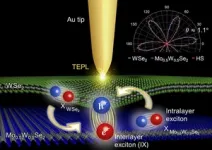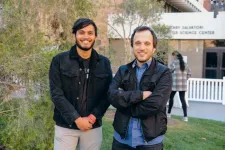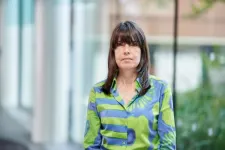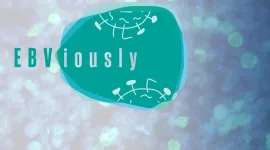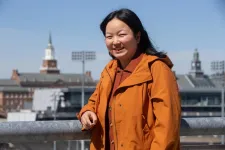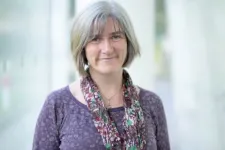(Press-News.org) Haley Marks is a project scientist for the Advanced Light Microscopy Lab (ALMS) at the CNSI at UCLA. She is a biomedical engineer with a specialty in nano-biosensor research, translational medicine, and optics education.
Since joining CNSI in 2022, Haley has served as a technical expert, providing advanced light microscopy training and services to ALMS users. Here she works on developing and optimizing ALMS’s existing super-resolution and high-speed optical methods, developing strategies and imaging tools for in vivo imaging, and optimizing and disseminating computational imaging techniques.
Haley has a passion for all things photonics, and enjoys 3D printing, materials science, and nanoparticle chemistry as well. She is also an avid skier, bread snob, and full-time cat mom. She was a past recipient of the 2014 Whitaker International Fellowship and 2018 SPIE Franz Hillenkamp Fellowship in Problem-driven Biophotonics.
We asked Haley 5 Questions about her unique career path that led her to UCLA:
1. Tell us about your work as a project scientist at the ALMS?
So here at ALMS we have a large collection of ‘toys’ – really advanced microscopy techniques – lightsheet, super-resolution, 2-photon, and FLIM systems all in one space. Now, these microscopes are not your average microscope – and they are all cutting edge techniques, and therefore relatively complex to operate. My goal is to make using these microscopes and interpreting the data less intimidating for our users – who come from all different backgrounds and have different needs, and get them excited about imaging.
For example a biologist may need help keeping their sample alive throughout the long laser exposures during imaging, where a physicist may need to monitor factors like magnetism or temperature while they image. I especially enjoy when people bring in difficult challenges or have been struggling to get that perfect image or are confused by their data, and we have to really put our heads together to engineer a unique solution for their problem. We are also a Leica Center of Excellence, which means we have a special insight into the industry side of microscopy development as well, and this creates a very symbiotic relationship where Leica can better understand their average user, and we have a better understanding of their products to best inform the users of limitations and possibilities of each scope.
2. How did your own past inform this work?
I’ve switched around a lot deciding exactly what sub-specialty I wanted to do, which I thought was a bad thing but turned out to be a very good thing now that I work with such a wide range of people. Biomedical engineering is a bit of a broad major, which can be a blessing and a curse, because it acts as a platform to a wide variety of fields, but you feel a bit like a Jack of all trades/master of none.
My one constant has been photonics – I have a motto that ‘photons are the new electrons’ and felt that regardless of what I did I knew this would be a booming industry, so I tried a few different things to see what I liked best. During undergrad I worked as an intern at a telecommunications company that made fiber optics for satellites – which seems vastly different from what I do now, but was the place I first fell in love with lasers, and also the first place I had an amazing mentor who really pushed me to continuously identify what I enjoy and keep pivoting towards it. Then during grad school I worked with plasmonic nanoparticles, and found that I actually enjoyed chemistry a lot more than I thought and wanted to merge my background in optics and nanotechnology. Finally for my postdoc, I worked at a hospital, which opened my eyes up to the immense number of opportunities to bring photonics technologies and benchtop biological discoveries into the medical application space. So its this mix of a little bit of optics, a little bit of nanoparticle chemistry, and a little bit of translational medicine that brought me here now to this very interdisciplinary space.
3. You have a unique background in science. Where do you draw your inspiration?
I’ve always been the curious type with a strong need to know not just how something works but ‘why’ it works the way it does. In science there is this glorious sense of gratification and relief that comes from figuring out the solution to a problem that has been driving you, and likely other scientists, absolutely mad for months.
Laurent Bentolila, our director at ALMS, has a Fermi quote on his office door that wonderfully encompasses the endless inspiration that science gives me: “If the result confirms the hypothesis, then you’ve made a measurement. If the result is contrary to the hypothesis, then you’ve made a discovery.” It means you cannot go wrong! Science is the one place where failures can inspire curiosity even more so than successes, and there is something beautiful about that.
4. What are some of the projects you are working on at ALMS?
We have so many cool projects that walk through these doors each week it’s hard to pick just a few! We very regularly image cells and slides, but things get interesting whenever people want to image whole living organisms, bulk tissues like a mouse jaw (with teeth!), or engineered tissues from xenografts or artificial constructs. I also enjoy when physicists and engineers really want to push the boundaries of our capabilities, since this is what leads to innovation and enables us to provide better microscopy in the future, for example when we image materials such as semiconducting crystals or plasmonic nanoparticles. There is always this magical moment when they finally get the image that confirms their hypothesis or takes their research in another direction.
5. Where did your love of science come from and what advice would you give to other young female scientists?
I think I didn’t know I had a love for science until I was actually doing science myself. I had a knack for math, but until I got into labs, I didn’t really understand the many cogs of the scientific machine and how may cross-disciplinary opportunities exist. So my advice is to get into a scientific environment right away and watch people, watch their roles and responsibilities and think about where you would be happiest and what drives you to come back to the lab each day. Try out as many different things as you can while you’re young and don’t let yourself be siloed by your past experiences, that way you fully open yourself up to understand what you like, or more importantly, what you don’t like. People, and especially those who identify as women, may not think they are ready or qualified when presented with a new opportunity. But the reality is that the majority of people feel that way, and fewer people than you think actually hit that apply button. So in short, apply to things! And if you discover you don’t like it, don’t be afraid to leave too: science is a foundational way of thinking and these experiences will help you regardless of your ultimate career path.
END
5 Questions with CNSI’s Haley Marks
2023-04-05
ELSE PRESS RELEASES FROM THIS DATE:
Young dog owners tend to cope well when their beloved pooch misbehaves, new study reveals
2023-04-05
A new study published in the CABI journal Human-Animal Interactions reveals that young dog owners tend to cope well when their beloved pooch misbehaves.
Past studies suggest that around 90% of dogs display undesired behaviours such as aggression and disobedience, but little is known about the impact of this on young people’s experiences and accompanying emotions.
A team of scientists interviewed young dog owners in Canada, aged 17 to 26 years, to try and determine their experiences with their pets and their coping strategies in response to bad behaviour.
This included barking occasional and persistent barking and, in extreme cases, being aggressive towards other dogs ...
Robots predict human intention for faster builds
2023-04-05
Humans have a way of understandings others’ goals, desires and beliefs, a crucial skill that allows us to anticipate people’s actions. Taking bread out of the toaster? You’ll need a plate. Sweeping up leaves? I’ll grab the green trash can.
This skill, often referred to as “theory of mind,” comes easily to us as humans, but is still challenging for robots. But, if robots are to become truly collaborative helpers in manufacturing and in everyday life, they need to learn the same abilities.
In ...
Hot probe tip contributes to making “transformer” semiconductor particles
2023-04-05
How can we make wearable devices like Spiderman’s suit that are thin and soft yet also feature various electrical and optical functionalities? The answer lies in producing novel materials that go far beyond the performance of existing materials and developing technology that enables the precise control of the physical properties of such materials.
Separating transition metal dichalcogenide (TMD) into a single layer just like graphene makes it transform into a thin, two-dimensional (2D) film material that exhibits the characteristics of highly performing semiconductors. By stacking two disparate ...
Series of new studies refute assumptions about link between power and concern about reputation
2023-04-05
Contrary to earlier research findings, people of power - think about politicians, celebrities or bullies in school - turn out to be no less concerned about their reputation, compared to those who have less influence and control within the society.
Previously, it has been assumed that since those who have the upper hand in the society - unlike the ‘powerless’ - are able to get away with commonly unacceptable behaviour (e.g. aggression and exploitation), would care less about any potential damages to their reputation.
However, a recent study by scientists at the University of Kent (United Kingdom) ...
Society matters LIVE: Lab made meat on the menu?
2023-04-04
• Research at Aston University focuses on both creating lab-based meat and its psychological acceptance
• Dr Eirini Theodosiou and Dr Jason Thomas will be speaking at April’s Society matters LIVE event
• Lab made meat on the menu? will take place at Cafe Artum in Hockley Social Club on Thursday 27 April.
Lab made meat will be the topic of the latest Society matters LIVE event from Aston University at Café Artum at Birmingham’s Hockley ...
Students use machine learning in lesson designed to reveal issues, promise of A.I.
2023-04-04
In a new study, North Carolina State University researchers had 28 high school students create their own machine-learning artificial intelligence (AI) models for analyzing data. The goals of the project were to help students explore the challenges, limitations and promise of AI, and to ensure a future workforce is prepared to make use of AI tools.
The study was conducted in conjunction with a high school journalism class in the Northeast. Since then, researchers have expanded the program to high school classrooms in multiple states, including North Carolina. ...
DZIF-project-derived start-up “EBViously“ announces first details of its EBV vaccine candidate
2023-04-04
EBViously, a spin-off from Helmholtz Munich (HMGU), is led by world-leading experts in Epstein-Barr virus biology, genetics, and immunity and was founded to develop a safe and highly effective preventive vaccine against a range of diseases caused by Epstein-Barr virus (EBV), including infectious mononucleosis, immune disorders, multiple sclerosis, and various cancers. The spin-off is based on a project of HMGU supported by the German Center for Infection Research (DZIF). The project leading to the spin-off was co-funded by the DZIF to enable GMP manufacturing ...
Preventing urban flooding in the face of climate change
2023-04-04
Planners have come up with many innovative ways to prevent flooding caused by heavy downpours — from planting rain gardens to installing green roofs.
But in many cases, nothing works quite as well as a simple hole in the ground — a detention basin.
That’s the finding of an analysis by University of Cincinnati geography students in a research collaboration with the Hamilton County Conservation District.
Lead author and UC College of Arts and Sciences doctoral student Man Qi said cities are developing new ways to trap rainwater and direct it where it’s most wanted, especially during droughts. They call these low-impact development practices, which ...
Genome-wide CRISPR screens identify PARP inhibitor sensitivity and resistance in prostate cancer
2023-04-04
Prostate cancer tumors harboring BRCA1/2 mutations are exceptionally sensitive to PARP inhibitors, while genomic alterations in other DNA damage response (DDR) genes are less responsive. To identify previously unknown genes whose loss has a profound impact on PARP inhibitor response, researchers from Dana-Farber Brigham Cancer Center led a multinational effort to perform genome-wide CRISPR-Cas9 knockout screens. The study goal was to inform the use of PARP inhibitors beyond BRCA1/2-deficient tumors and support reevaluation ...
Aston University biomass expert calls for more exploration of power bioenergy with carbon capture and storage
2023-04-04
Professor Patricia Thornley welcomes latest UK energy security plans
But calls for more exploration of bioenergy with carbon capture and storage
She believes plans shouldn’t concentrate solely on energy such as wind and solar power.
A leading biomass scientist at Aston University has welcomed the government’s announcement to ensure UK energy is more secure.
However, Professor Patricia Thornley, director of Aston University’s Energy and Bioproducts Research Institute (EBRI), believes the government ...
